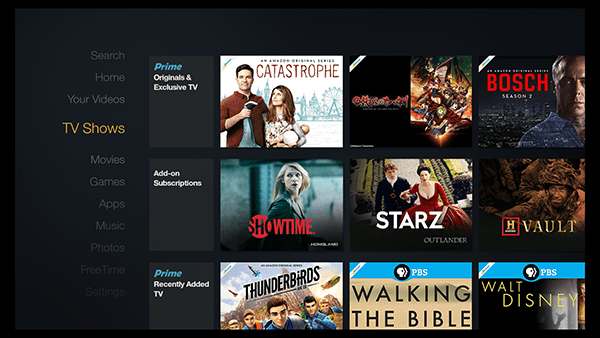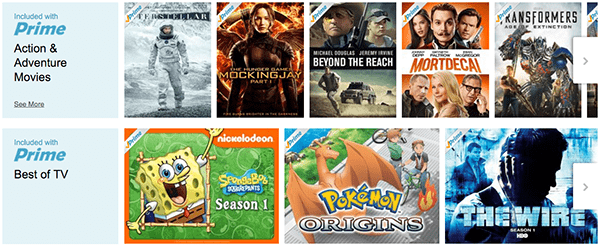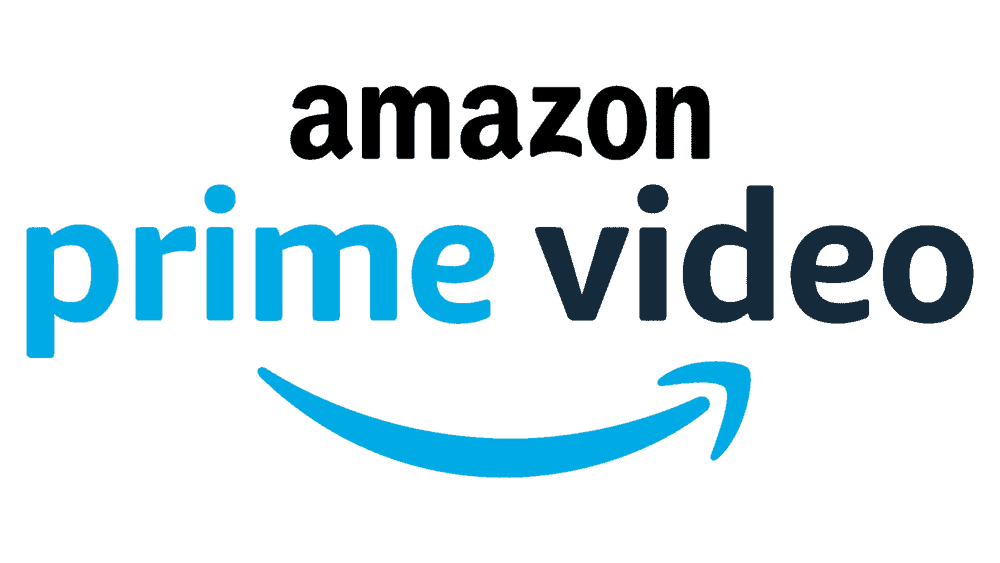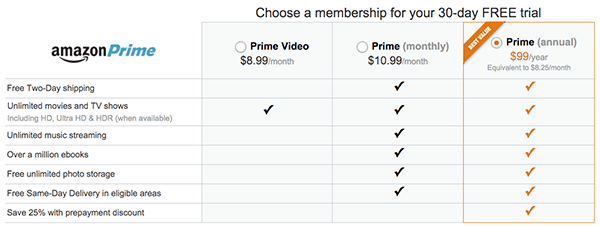User Experience
In its various apps, Amazon presents its content similarly to how Netflix does. It shows its titles in rows, sorted into categories based on things like genres and suggestion algorithms. Navigation is simple and clicking on a title brings up more details, including a description, cast list, and user rating.

One cool thing that Amazon Video does is feature facts and trivia about some content when you tap your screen on the mobile apps. It’s not a huge feature, but it’s a fun little detail.
The most unique thing about Amazon Video is the way in which its integrated with Amazon’s larger pay-per-view and purchase library. You can change a setting to view only included streaming video, but in some places (like on Fire TV and on certain pages of Amazon.com), the default settings mix the Prime/Amazon Video content in with movies and TV shows that you can buy or rent. Included videos are set apart by a “Prime” label in the upper-right corner, but I still clicked on a few paid videos by mistake. It was disappointing to choose content and then realize that it wasn’t included.
Changing a simple setting solves this problem, but it’s illustrative of the general way in which Amazon Video is integrated into Amazon’s offerings. Nowhere is this more true than on Fire TV, which puts suggestions from Amazon Video and Amazon’s rental and purchase options all over the operating system’s main tabs, rather than housing them within an app. But it’s true to an extent on other platforms, too – you’ll see ads for add-on subscriptions presented in their own row between the rows of content you already have access to, and you’ll sometimes see ads for Amazon’s original series before your chosen content begins.

It’s worth talking in a bit more detail about the Prime experience on Fire TV, because it’s definitely different. Fire TV integrates Amazon Prime’s offerings – including Amazon Video, Amazon Music (a streaming music service) and Amazon Photos (a photo storage app) into the operating system’s main menu. As a result, there’s no need for a standalone app. It’s a pleasant experience, but obviously a very Amazon-centric one. And it’s important to note that Amazon’s monthly Amazon Video subscription does not include Amazon Photos or Amazon Music, as the annually priced Amazon Prime does.
Content

Content-wise, Amazon is strong and growing stronger. It has a ton of TV and movie options, including properties from HBO, PBS, Nickelodeon, and more. There are some fairly recent feature film hits in the mix, including (at the time of this writing) Interstellar and The Hunger Games: Mockingjay – Part I, among others.
Streaming content from TV and movie studios is important, but the OTT business has increasingly been about the original series arms race. Amazon’s original content lags behind Netflix’s and HBO (original content is what HBO is all about, after all). But it’s gaining fast thanks to strong efforts like Transparent and The Man in the High Castle.
For now, in our opinion, Amazon Video’s library can’t measure up to Netflix’s. But it’s a fitting rival for HBO and Hulu, and its content complements Netflix’s library, so users who are willing to pay for more than one streaming service at once should definitely have Amazon Prime on their shortlist.
Additional content can be added to Amazon Video or Amazon Prime by paying for add-on subscriptions. Options include Starz and Showtime.
Streaming Quality
Amazon Video streamed well on all the devices we tried it on. On Wi-Fi, it sometimes dips back into standard definition, but it very rarely gets choppy or has to reload. Overall, the quality was very comparable to Netflix’s.
There didn’t seem to be a huge difference in streaming quality across the different platforms. It was a little better on devices with wired connections than it was on Wi-Fi, but we’ve come to expect that with all services.
Platforms
Amazon Video is available through the Amazon Video app on a wide variety of platforms. We tried it out on Amazon Fire TV, Roku 4, Roku Streaming Stick, iOS, Android, Chromecast (casting from iOS and Android), and via the web app. There weren’t any huge differences in streaming quality or user experience between these platforms, except for the Fire TV user experience, which was slightly different.
As you might expect, Amazon Prime is most seamlessly integrated into the Amazon Fire TV interface. We touched on this in our Amazon Fire TV review, and it’s in keeping with Amazon’s general strategy – all of its offerings are interconnected. Of course, Amazon Prime and Amazon Video are still very useable even if you don’t have a Fire TV (just as Fire TV is still a good product even if you don’t have Prime or an Amazon video library), but it’s worth noting that the integration is there.
Price – Amazon Prime vs. Amazon Video
Amazon Prime – which includes Amazon Video, Amazon Music, free two-day shipping, and more – costs $99 a year (equivalent to $8.25 per month). Amazon Video alone (without those extra perks) is available as a monthly subscription price at $8.99 a month. That’s slightly cheaper than Netflix’s most popular package ($9.99/month) which is the most comparable to Amazon Video, as it allows streaming on multiple devices and includes HD video.
Verdict
No streaming service has gotten good faster than Amazon Video, but that doesn’t mean its quite ready to take on Netflix. Amazon Video’s base content library is, in our view, not as good as Netflix’s. If you only subscribe to one service, we’d stop short of recommending Amazon Video. The only reason to pick it in a head-to-head over Netflix would be the full Prime membership version, which includes perks like free two-day shipping.
However, if you’re looking to add another streaming subscription on top of Netflix, Amazon is a strong contender. Its catalog is quite strong and compares well to Hulu’s and to HBO’s (as we mentioned, Amazon Video includes a lot of HBO programs). Amazon Video streams well, is easy to use, has a ton of platform support, and comes at a great price point. It complements Netflix quite well, since their two catalogs don’t overlap much. For users who want multiple subscriptions, Amazon Video is an excellent choice.



Good review! Haven’t had a TV for 3 years and I was alternating between Netflix and Hulu. Now I am trying out Amazon. They all have their pros and cons.
The article date is for December 2019 but I think the article content is outdated. Amazon Prime Video has been decreasing its content variety and quality. Week to week and month to month the content shrinks. Add to that the increased membership cost, one has to wonder wether it is worth keeping the Prime membership. In terms of content, Netflix is better. Do not be swayed.
I’ve been trying to nail down the actual cost of watching films on Amazon Prime Video, it’s like looking for a needle in a haystack, which rather puts me off if the can’t be open and honest about the costs involved. Might consider Netflix instead, but even their content isn’t great. I’ve seen better on Emirates in-flight entertainment.
The article says changing a simple setting resolves the fee notice on many ideas, but never mentions what this simple setting is.
I have an amazon prime membership, but recently some of the TV series I used to watch for free now require purchase.
I have not been able to determine why or how to get back to the “included with Prime” designation
Hi Phil — unfortunately, things won’t necessarily stay on streaming services like this forever. Amazon cuts deals with the people who own the movies and TV shows, and they get the shows and movies under contract for a while. But, just like a free agent might change teams in sports, the content owners might decide not to sign with Amazon again when their contract runs out. They might go to Netflix, Hulu, HBO, etc. instead. The only shows and movies that you can be pretty sure will stick around forever are the Amazon originals. (If you choose to buy a show from Amazon, that’s a different thing. You’ll keep anything you buy pretty much indefinitely, whether it’s on Amazon Prime Video or not. You also don’t have to have Amazon Prime to buy or rent things — Prime only matters for the free selection.) Hope this helps, and thanks for reading!